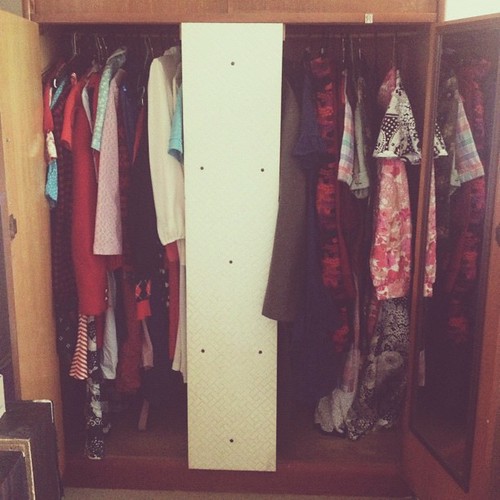Have you ever been so captivated by the sheer volume of fabric in a dress that it feels like a personal fortress? A statement piece that not only turns heads but also conveniently ensures a bubble of personal space in any crowded room?I have, and let me tell you, it’s a love affair that’s both fabulous and fraught with complexity.
My latest acquisition, a stunning ball gown priced at a mere £30 down from £700, is the fifth to join my collection. It’s not just about the dress itself, but the intoxicating rush of snagging a luxury item for less. This habit, which started in my 20s, has filled my wardrobe with pieces I’d never dream I could afford. I still remember the thrill of my first designer buy—a Christian Dior skirt for just £10. It hung over my bed like a trophy, a symbol of the person I aspired to become.

But as my collection grew, so did a creeping sense of panic. I was amassing clothes at an alarming rate, and the joy of the bargain began to be overshadowed by the weight of my possessions. Hoarding, as I would come to learn, is not just about having too much stuff. It’s a complex behavior that can stem from early coping mechanisms, as psychotherapist Toby Ingham explains. For some, managing difficulties through rituals and routines can inadvertently lead to hoarding.
Despite my growing awareness, pinpointing the exact origin of my hoarding tendencies proved elusive. It was a gradual process, not an overnight transformation. And while I didn’t fit the stereotype of a ‘proper hoarder,’ the signs were all there: the distress at the thought of discarding items, the inability to use my living space as intended, and the emotional turmoil that came with each attempt to declutter.

Mandi, a Hoarding UK trustee, became a beacon of hope for me. Her story on a documentary resonated deeply, as she too had a love for vintage clothing and a collection that told a thousand stories. Her journey highlighted the reality of hoarding disorder—a condition that can quietly take over one’s life without notice.
My own struggle with hoarding mirrored Mandi’s. I prioritized shopping over social engagements, hid my acquisitions from guests, and felt a profound sense of loss at the thought of parting with any item. Each piece was tied to a memory, a dream, or a version of myself that I wasn’t ready to let go of.
The turning point came when I realized that my possessions were not just clutter; they were barriers to the life I wanted. I began to confront the issue head-on, selling hundreds of items and starting to write about my experiences. It was a painful process, but also liberating. I learned that letting go of the physical items made room for new opportunities and personal growth.
As I worked through my hoarding behaviors, I found solace in the words of experts like Ingham and the support of those who had walked a similar path. The act of hoarding, often a response to anxiety, creates an illusion of control. But in reality, it can leave one feeling trapped and isolated.
My journey is far from over, but I’ve made significant strides. I’ve learned to shop more mindfully, to embrace the present, and to let go of the things that no longer serve me. And as I approach my 40th birthday, I’m finally stepping into the life I’ve always envisioned—one where I am not defined by my possessions, but by my actions and aspirations.
The story of my hoarding is not just about the clothes.
It’s about the dreams they represented and the reality I’m now creating. It’s a tale of self-discovery, of finding balance, and of the courage to change. So, as I prepare to embark on my coastal walk, I do so with a lighter load, both physically and emotionally. And I can’t help but feel a sense of excitement for the journey ahead, unencumbered by the past and open to the endless possibilities that life has to offer.
Diving into the second chapter of my journey, I want to share the transformative road to recovery and the art of embracing change. The process of letting go is not just about discarding physical items; it’s about shedding the layers of self that are no longer in alignment with who we are becoming. It’s about creating space for new energy, experiences, and the true essence of self-expression.
My hoarding was blocking the life I wanted.
It wasn’t just about the clothes; it was about the dreams and aspirations they symbolized. Each garment was a narrative thread in the tapestry of my imagined life, but they were also the very knots that kept me from moving forward. The act of hoarding, as Ingham pointed out, is often a response to anxiety, creating an illusion of control. But this control was illusory, and the need to break free became undeniable.
The journey of letting go began with small, tentative steps.
It was a process that required patience, self-compassion, and a willingness to confront the emotional attachments I had formed. The yellow, one-shoulder, floor-length dress earmarked for an awards ceremony, the black-lace tea dress for a date—each item was steeped in a fantasy of a future self. But the truth was, these items were not just unworn; they were unwearable, representing an idealized version of myself that didn’t exist.
The decluttering process was cathartic, with some doubt and regret.
Selling 400 items at a clothing sale was a monumental task, but it was also an opportunity to connect with others and witness the joy my belongings could bring to their lives. The psychologist’s warning about the rush of selling mirroring the thrill of buying was a cautionary tale, reminding me to stay grounded and focused on the end goal.
As I parted with each piece, I felt a mixture of emotions—loss, relief, and sometimes a sense of reclaiming my identity. It was a tangible way of saying goodbye to the person I thought I needed to be and hello to the person I truly was. The act of selling, donating, and responsibly discarding items became a ritual of release, a way to honor the past while making room for the future.
The impact of my hoarding on others was something else I had to deal with.
My housemates, my parents, and my friends had all been affected by my behavior, though they approached it with kindness and understanding. The shared cupboard that wouldn’t close, the flatmates who didn’t complain, the parents who helped without judgment—all these moments were reflections of their love and my own internal struggle.
In facing my hoarding, I had to face its reasons.
The end of a difficult relationship, the departure from London, the feeling of stagnation—all these factors contributed to my need to hoard. It was a way to fill the void, to create a sense of accomplishment and identity when I felt I had none. But as I began to peel back the layers, I discovered that the things I clung to were not just obstacles; they were signposts pointing me towards my true passions and desires.
The pandemic, while halting my plans to hike the South West Coast Path, provided an unexpected opportunity for introspection and change. The forced proximity to my possessions made it impossible to ignore the need for a shift. It was during this time that I began to invest in my dreams of writing, channeling my energy into creative pursuits rather than material accumulation.
The success of my play ‘Breathless’ at the Edinburgh Festival Fringe was a testament to the power of transformation. By sharing my story, I not only connected with others who had similar experiences but also aligned myself with the person I had always aspired to be. The accolades and the tour were not just professional achievements; they were personal milestones marking my journey from hoarder to creator.
As I approach my 40th year, I am filled with a sense of anticipation and readiness for the adventures that lie ahead. The coastal walk I once planned is back on the agenda, this time with a lighter load and a heart open to the experiences that await. I am buying clothes that fit, embracing the present, and letting go of the past.
The road to recovery from hoarding is not a straight path; it is a winding trail with ups and downs, moments of clarity, and periods of doubt. But it is a journey worth taking, for it leads to a place of authenticity and freedom. The fabric of my life is no longer measured by the dresses I own but by the richness of my experiences and the depth of my connections.
The act of letting go is an ongoing process, one that requires vigilance and self-awareness. The instincts to hoard may resurface during times of stress or change, but the awareness and tools I have gained will help me navigate these challenges. Hoarding disorder is now recognized as a mental health condition, and the increasing dialogue around it offers hope and support to those on the path to recovery.
I am grateful for the lessons learned, the people who have supported me, and the opportunities that have emerged from my willingness to change. My obsession with the amount of fabric in a dress has evolved into an appreciation for the fabric of life itself—complex, beautiful, and ever-changing. And as I move forward, I do so with the knowledge that the most valuable things I possess are not things at all, but the experiences and relationships that weave the colorful narrative of my life.
Related posts:
I’ve always bought too many clothes, but my life was being ruined by hoarding
How My Love Of Clothes Became A Hoarding Problem | British Vogue





